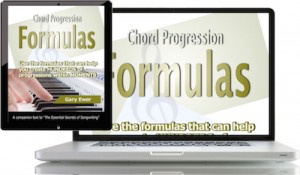Do you find that getting chords to sound right is the hardest part of getting a song working? Chord theory is a topic that takes considerable study to understand it thoroughly, so let’s look at it from a different angle.
Here are 7 things about chord progressions that many songwriters don’t know. It may help you understand why you find some chords sound great together while others sound confusing. It won’t replace studying chord theory, but can help answer some questions you’ve always had about this tricky part of songwriting.
1. Creating Chord Progressions is Not a Random Process
Just because you’ve been able to create chord progressions in the past by randomly picking and choosing chords doesn’t mean that it’s a random process. It isn’t – there is a reason why some chords work and others don’t.
Every key, whether major or minor, has 7 pitches that make up its scale. You can build a 3-note chord on each scale note, and that gives you the 7 chords that exist naturally in that key. (C major: C, Dm, Em, F, G, Am, Bdim). That’s a start. From there, you can add altered chords, modal mixtures, and so on.
The choice is up to you, and so that part is random. But most songs will concentrate on those 7 naturally-occurring chords that come from the scale.
2. Most Chord Progressions are Mainly Strong, Tonally-Speaking
A strong progression is one that makes the tonic chord sound like a target, or an anchor. When you play C-F-G7-C, you can hear that the chord C gives a strong sense of “home.” In pop songwriting, most progressions are strong, which means that even if they wander away from the key a bit (as you might possibly find in a verse or bridge), they don’t wander for long. They keep the tonic chord strongly in its sights.
Creative chord progressions can be interesting and powerful, but if they’re too complex or random-sounding, they can confuse the audience. Most hit songs make great use of strong, simple, basic progressions, and rarely go into the world of complex or “fragile.”
3. The Roots of Chords in Most Progressions Are Often a 4th Or 5th Apart
Take a look at the chord progressions of most successful pop songs, and you’ll find that the roots of adjacent chords are often (not always) a 4th or 5th apart. In the simple progression C-F-G7-C, there is an ascending 4th between C and F, and then a descending 5th between G7 and C. That interval is an important part of making progressions sound natural and strong.
 If you’re a chords-first kind of songwriter, you need this eBook: Writing a Song From a Chord Progression. It gives you a step-by-step process for getting from chord progression to finished song. It’s part of the 10-eBook Deluxe Bundle. Read more..
If you’re a chords-first kind of songwriter, you need this eBook: Writing a Song From a Chord Progression. It gives you a step-by-step process for getting from chord progression to finished song. It’s part of the 10-eBook Deluxe Bundle. Read more..
4. Predictability With Chord Progressions is Usually a Positive Characteristic
Songwriters instinctively dislike excessive predictability, but predictable chord progressions is usually completely fine. The fact that you can’t copyright a chord progression is due to the fact that they get used again and again in different songs. Tossing in something unpredictable every once in a while can be interesting and good, but chord progressions should be mainly predictable.
5. Pedal Point Can Make an Otherwise Boring Progression Sound Much More Interesting
A bass pedal point means that you play the same note in the bass while the chords above it change. Typically, you’re most likely to see either the tonic (1st) note or the dominant (5th) note being played, but it’s worth experimenting with other tones.
So if you find that you’re bothered by how mundane this sounds: C F G7 C – try keeping the note C in the bass while the chords change. That gives you this: C F/C G7/C C. (The note after the slash is the bass note).
6. Chord Inversions (“Slash Chords”) Can Add a Strong Sense of Direction to a Chord Progression
Usually when you play chords, you’re playing them in root position, which means that the letter name of the chord is the lowest-sounding note. But you open up a whole new world in the sound of chords by inverting them. So try experimenting by placing either the 3rd of the chord in the bass (C/E) or perhaps the 5th (C/G).
It’s best if you have a reason for doing this, and the most common reason for using chord inversions is to smooth out a bass line (so that C G Am becomes C G/B Am)
7. You Can Use Other Songs’ Chord Progressions Without Their Permission
Chord progressions are not protected by copyright, and so you can use whatever you want in your own songs. But remember this: you can borrow the chords, but you stray into a tricky area if you also borrow the backing rhythms and instrumental effects. Progressions can be taken and used because they’re used so often that no one can claim to have written them. But if you then take the instrumental accompaniment, complete with guitar and percussion effects — now the progression sounds like something else other people have heard, and you’ve likely violated copyright. That is the main reason that Robin Thicke and Pharrell Williams lost their “Blurred Lines” copyright battle with the Marvin Gaye estate.
But simply taking another progression? There’s nothing wrong with that, and that can be a great way to break out of a songwriting slump, if you simply can’t come up with a chord progression you like.
 Written by Gary Ewer. Follow Gary on Twitter
Written by Gary Ewer. Follow Gary on Twitter
 “Chord Progression Formulas” will show you how to create dozens of chord progressions literally within seconds. This high-quality PDF manual is part of “The Essential Secrets of Songwriting” eBook Bundle packages. Right now, get the 10-eBook Deluxe Bundle at a DISCOUNT PRICE. Read more..
“Chord Progression Formulas” will show you how to create dozens of chord progressions literally within seconds. This high-quality PDF manual is part of “The Essential Secrets of Songwriting” eBook Bundle packages. Right now, get the 10-eBook Deluxe Bundle at a DISCOUNT PRICE. Read more..












Pingback: Song Lyrics Best Part | Lirik Kata